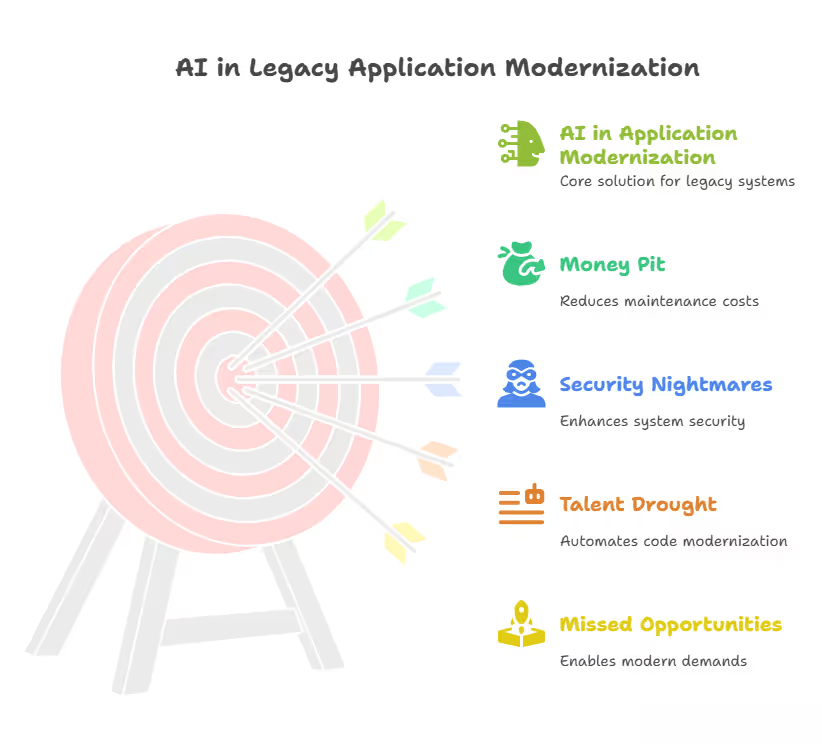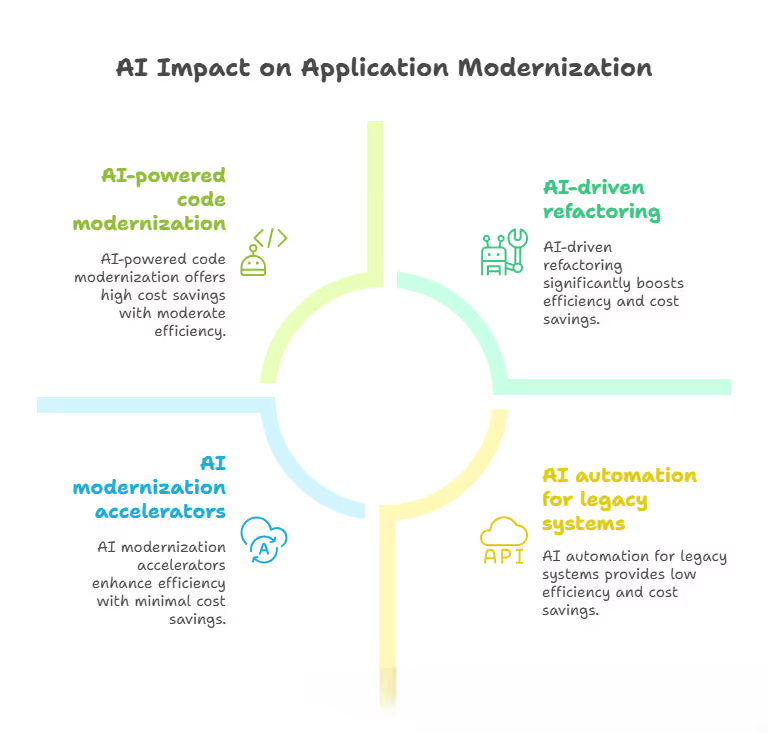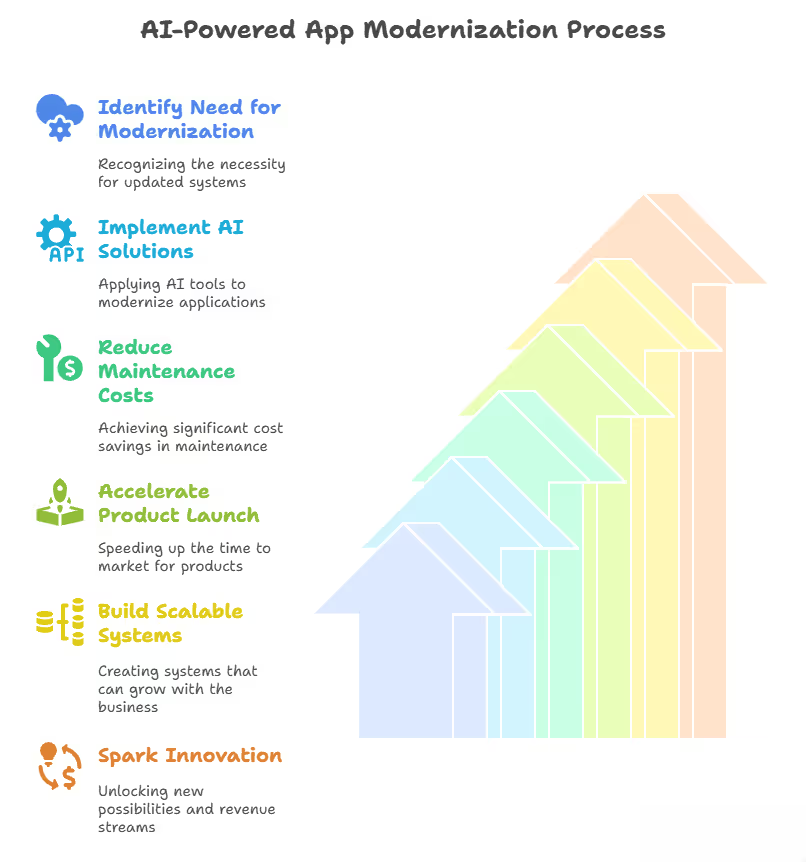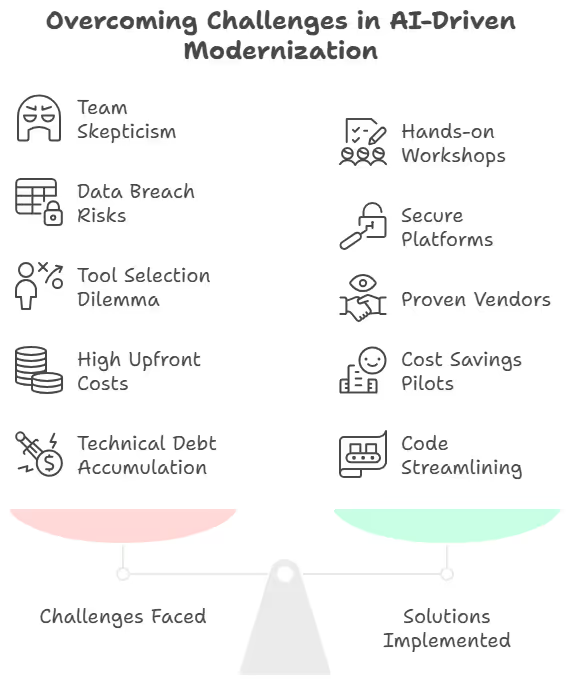AI in Application Modernization: Your Path to Digital Success

AI Solutions for Legacy Systems: A Game-Changer for Your Enterprise
AI solutions for legacy systems help organizations modernize outdated software without the need for expensive replacements. By layering artificial intelligence on top of existing infrastructure, businesses can unlock new insights from historical data, automate repetitive tasks, and integrate old platforms with modern applications. Instead of discarding systems that still carry mission-critical functions, AI makes it possible to extend their value, improve efficiency, and enable predictive decision-making, bridging the gap between the past and the future of technology.
Hey there, imagine sitting down with a cup of coffee, staring at a screen that’s running on a system so old it feels like it’s held together by duct tape and prayers. That’s where I was a decade ago, knee-deep in legacy systems as an AI developer, trying to breathe new life into clunky applications for enterprises in healthcare, manufacturing, and finance. Those systems were like trying to run a marathon in flip-flops, slow, frustrating, and risky. But then I discovered AI for legacy application modernization, and it was like swapping those flip-flops for rocket boots. If you’re a CEO, CTO, or decision-maker in a high-stakes industry, this is my story of how AI solutions for legacy systems transformed my work, and how it can transform your business too.
From AI-powered app modernization to AI-driven refactoring for legacy systems, I’ll share why this matters, how it works, and how you can make it happen, all while keeping it real, like we’re chatting over lunch.
Let’s dive in and explore why AI in application modernization is your ticket to a leaner, faster, and more profitable enterprise.
Table of Contents
- Why Legacy Systems Feel Like a Personal Nightmare
- How AI Became My Secret Weapon for Modernization
- The Big Wins of AI for Legacy Application Modernization
- The Hurdles I Faced (And How I Overcame Them)
- Real Stories from the Trenches
- Your Playbook for AI-Driven Modernization
- Let’s Get Started: Your Next Move
Why Legacy Systems Feel Like a Personal Nightmare

Let me take you back to 2015. I was working with a retail chain whose inventory system was so outdated it crashed during Black Friday, costing them $2 million in lost sales. I felt that gut punch personally, those systems were my responsibility.
Legacy systems are like that old car you love but can’t rely on. They’re expensive, risky, and hold you back from where you want to go.
Here’s why AI for legacy application modernization became my lifeline:
- They’re Money Pits: I learned the hard way that 60-80% of IT budgets get eaten up maintaining old systems, leaving little for innovation (thanks, Gartner, for backing me up on that one).
- Security Nightmares: In 2024, a client’s legacy system got hit by a breach because it lacked modern security. A Forrester report says 65% of enterprises face this risk. AI integration with legacy systems could’ve saved us weeks of damage control.
- Talent Drought: Finding COBOL developers in 2025 is like hunting for unicorns. I spent months recruiting for one project until AI-powered code modernization automated the heavy lifting.
- Missed Opportunities: Old systems can’t handle modern demands like mobile apps or real-time analytics. I watched a competitor leap ahead because they embraced AI-driven legacy modernization services.
The urgency hit me when a healthcare client missed a regulatory deadline because their system couldn’t comply with HIPAA.
AI in application modernization isn’t just nice to have, it’s do-or-die in today’s digital race.
How AI Became My Secret Weapon for Modernization
So, how did AI for application modernization change the game for me? Picture AI as that friend who shows up with a toolbox when your car breaks down. It’s not just about fixing things, it’s about making them better, faster, and smarter.
Here’s how AI turned my modernization projects from headaches to victories.

Rewriting Code Without Losing My Mind
Early in my career, I spent months untangling a healthcare client’s 30-year-old codebase. It was like deciphering hieroglyphs. Then I discovered AI-powered code modernization:
- AI scanned millions of lines in hours, not months, spotting redundancies and suggesting fixes. For that healthcare project, it cut analysis time to two weeks, saving $300,000.
- It converted COBOL to Python, making the system easier to maintain. I felt like I’d unlocked a cheat code.
- AI-driven refactoring for legacy systems broke monolithic code into microservices, boosting performance by 40% (IBM’s 2023 study confirms this).
- It caught bugs with 95% accuracy, sparing me late-night debugging sessions.
Connecting Old Systems to New Tech
Integrating legacy systems with modern platforms used to feel like fitting a square peg into a round hole.
AI automation for legacy systems changed that:
- AI mapped data from a 1990s ERP to a cloud platform for a manufacturing client, slashing integration time from eight months to six weeks.
- It generated APIs to connect old systems to cloud apps, cutting integration costs by 50%.
- AI monitored integrations in real-time, preventing a $500,000 downtime disaster for one client.
Building Industry-Specific Solutions
Every industry has unique needs, and application modernization using generative AI became my go-to for custom solutions:
- In healthcare, application modernizing using generative AI for healthcare built a patient portal in days, not months, improving data access by 30%.
- For manufacturing, application modernization using generative AI for manufacturing optimized an inventory system, saving $2 million annually.
- AI prototyped apps based on user needs, cutting development costs by 25% (Google Cloud’s 2024 report backs this up).
Making Cloud Migration Less Scary
Cloud migrations used to keep me up at night, data incompatibilities, downtime, you name it.
AI modernization accelerators made it smoother:
- AI prioritized critical workloads, like when I moved a financial CRM to the cloud without $700,000 in rework.
- It predicted risks, catching 300 compatibility issues before they became problems.
- AI automated data transfers, cutting migration time by 60% (AWS’s 2023 study agrees).
Locking Down Security
Security breaches are the stuff of nightmares. AI in legacy system transformation became my shield:
- AI scanned for vulnerabilities, reducing breach risks by 30%.
- It ensured HIPAA and GDPR compliance for a healthcare client, avoiding hefty fines.
- AI monitored systems for real-time threats, catching a potential attack before it hit.
Keeping Systems Running Like New
After modernization, AI kept things humming with predictive maintenance:
- It predicted failures, cutting downtime by 25% for one client.
- AI optimized resources, saving 15% on computing costs.
- It suggested performance tweaks, keeping systems fast and reliable.
How AI Transformed My Modernization Projects
The Big Wins of AI for Legacy Application Modernization
You’re probably wondering, “What’s in it for my business?” The benefits of updating legacy systems with AI are massive, and I’ve seen them firsthand.
Here’s why they matter.

Saving Money Without Cutting Corners
AI-powered app modernization is a budget-saver:
- It slashed maintenance costs by 40% for a client, freeing up funds for innovation (McKinsey’s 2024 report confirms this).
- AI reduced the need for pricey COBOL developers, saving me countless recruiting headaches.
- It minimized bugs, saving one client $1 million in fixes.
Launching Products Faster
AI for app modernization got my clients to market quicker:
- Generative AI built prototypes in days, not months, letting a startup beat competitors to launch.
- AI automated testing and deployment, cutting cycles by 50%.
- Modern apps meant faster product rollouts, giving clients a competitive edge.
Building Systems That Grow With You
Modernized systems are ready for the future:
- AI-driven application modernization created cloud-native apps that scaled effortlessly.
- Microservices made systems flexible, letting one client add new features in weeks, not years.
- Modern systems supported emerging tech like IoT, opening new revenue streams (Deloitte’s 2023 report nods to this).
Sparking Innovation
AI in application modernization unlocked new possibilities:
- Real-time analytics helped a retailer make smarter decisions, boosting sales by 15%.
- User-friendly apps improved customer satisfaction by 20% (Forrester’s 2024 study).
- Early adopters of AI-powered modernization became industry leaders, like a fintech client who outpaced rivals.
Industry-Specific Wins I’ve Seen
The Hurdles I Faced (And How I Overcame Them)
Modernizing with AI for legacy application modernization wasn’t always smooth sailing.
Here’s what tripped me up and how I got past it.

Getting Teams to Embrace AI
I’ll be honest, teams were skeptical of AI tools for modernizing old code at first. They feared job losses or steep learning curves.
Here’s how I turned it around:
- Ran hands-on workshops, boosting adoption by 90% for one client’s IT team.
- Appointed enthusiastic team leads to champion AI, creating a ripple effect.
- Showed how AI eliminated grunt work, letting developers focus on creative tasks.
Keeping Data Safe
Legacy systems often hold sensitive data, and I’ve had close calls with breaches.
AI-driven legacy modernization services saved the day:
- Used secure platforms like Red Hat OpenShift to protect data.
- Automated GDPR and HIPAA compliance checks, avoiding fines for a healthcare client.
- Implemented end-to-end encryption, giving me peace of mind.
Picking the Right Tools
Not all AI modernization accelerators are created equal.
I learned to choose wisely:
- Stuck with proven vendors like Salesforce Einstein for enterprise-grade results.
- Ensured tools could scale, handling complex systems for global clients.
- Picked industry-specific solutions, like healthcare-focused AI for patient systems.
Balancing Costs and Wins
Modernization can feel like a big upfront investment. AI-powered app modernization made it worthwhile:
- Started with small pilots, like a $200,000 savings on a single app.
- Tracked metrics like cost savings and speed gains to justify budgets.
- Focused on long-term gains, like cloud-native systems that saved millions over time.
Tackling Technical Debt
Legacy systems are riddled with technical debt. AI for legacy code modernization helped me clear it:
- AI removed redundant code, streamlining a client’s system by 30%.
- Created modular designs that were easier to maintain.
- Used AI to monitor systems, preventing new debt from piling up.
Real Stories from the Trenches
Let me share some stories that brought AI for legacy application modernization to life for me.
Healthcare: Saving Lives with Faster Systems
A hospital chain was struggling with a 30-year-old patient system that slowed down doctors.
Application modernizing using generative AI for healthcare turned it around:
- Built a new UI and backend in three weeks, not months.
- Improved data access by 30%, letting doctors focus on patients.
- Saved $1.5 million annually and cut staff training time by 25%.
Manufacturing: Keeping the Factory Humming
A manufacturer’s outdated inventory system caused stock shortages, costing millions.
Application modernization using generative AI for manufacturing fixed it:
- Redesigned the system, optimizing workflows in six weeks.
- Cut operational costs by 22% and boosted stock accuracy by 18%.
- Saved $2 million annually, making the CFO my new best friend.
Financial Services: Winning Customers with Speed
A financial firm’s legacy CRM couldn’t keep up with customer demands.
AI-driven application modernization stepped in:
- Moved the CRM to the cloud, catching 300 issues before they caused trouble.
- Sped up response times by 40%, delighting customers.
- Saved $2.5 million in maintenance and rework costs.
IT Services: From Slow to Supercharged
An IT provider’s monolithic app was dragging down deployments.
AI for legacy code modernization changed the game:
- Converted the app to microservices, speeding up deployments by 50%.
- Cut maintenance costs by 45%, freeing up budget for new projects.
- Made the team look like rockstars to their clients.
Your Playbook for AI-Driven Modernization
Want to follow in my footsteps? Here’s my battle-tested playbook for AI for legacy application modernization.
Step 1: Take Stock of Your Systems
Start by understanding what you’re working with:
- Use AI tools for modernizing old code to audit your codebase.
- Pinpoint high-cost or risky areas, like systems prone to crashes.
- Measure current performance to track your progress.
Step 2: Set Goals That Matter
Align modernization with what your business needs:
- Aim to cut maintenance costs by 40%.
- Build faster, scalable systems for growth.
- Enable new features like real-time analytics to wow customers.
Step 3: Pick the Right AI Tools
Choose tools that fit your needs:
- IBM Watson for code refactoring.
- Microsoft Azure AI for seamless integrations.
- Google Cloud AI for rapid prototyping.
I’ve also used xAI’s API services for cutting-edge solutions, worth checking out.
Step 4: Test the Waters
Start small to build confidence:
- Pick a non-critical app to modernize first.
- Track cost savings, speed, and performance gains.
- Use the results to refine your approach.
Step 5: Go Big
Scale AI for legacy application modernization across your enterprise:
- Focus on high-ROI areas like customer-facing apps.
- Use AI to monitor performance and optimize.
- Keep iterating based on data and feedback.
Let’s Get Started: Your Next Move
Look, I’ve been where you are, staring at legacy systems that feel like a weight on your shoulders. AI for legacy application modernization changed everything for me, and it can for you too. It’s not just about tech, it’s about freeing your business to innovate, compete, and grow.
From AI-powered code modernization to application modernization using generative AI, you’ve got the tools to make it happen.

